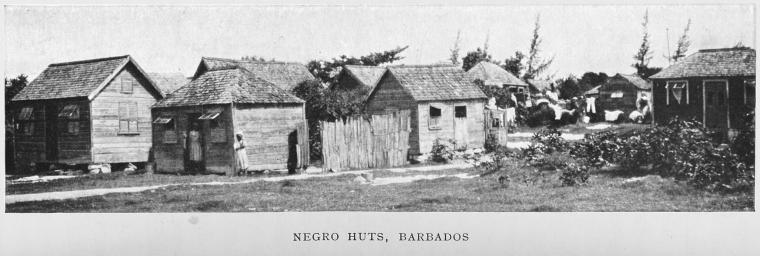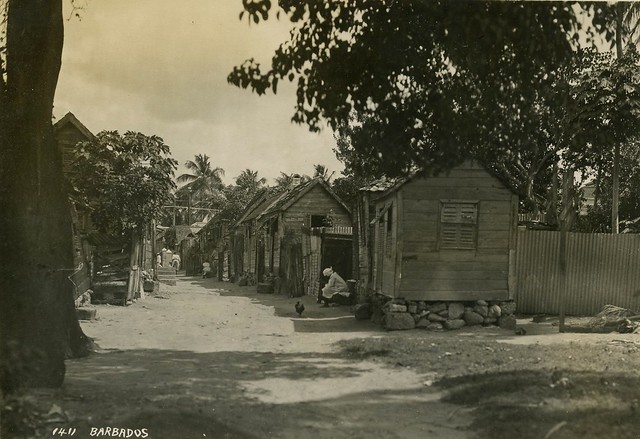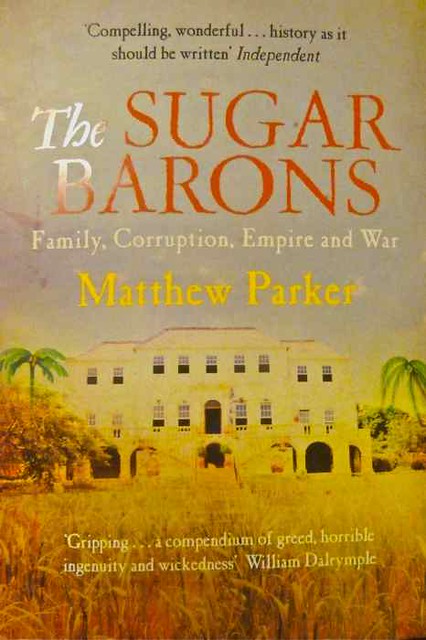
From the UK Guardian, "The Sugar Barons by Matthew Parker - review - The cane fields of the West Indies hid a corrupt society," by Ian Thomson, on 1 April 2011 -- In Jamaica recently, I was invited to lunch at a Restoration-era plantation house. The sound of crushed ice clinking against glass greeted me, as bow-tied waiters served guests at a long table draped in linen. The top brass of the island's sugar industry was there. For three centuries the plantation's slave-grown sugar had satisfied the British craving for cakes, confections and the popular version of coffee and tea (that "blood-sweetened beverage", the abolitionist poet Southey called it).
The Sugar Barons, by Matthew Parker
Modern Britain, according to Matthew Parker, was built on sugar. There is hardly a manufacturing town on these shores that was not in some way connected to the "Africa trade". The glittering prosperity of slave ports such as Bristol and Liverpool was derived in large part from commerce with Africa. In the heyday of the British slave trade, from 1700 to 1808, West Indians (as white sugar barons were then known) became conspicuous by their new wealth. A popular melodrama of 1771, Richard Cumberland's The West Indian, satirised them as boorish creatures who had settled in the Caribbean to acquire a fortune and a social status they would have been denied at home.
In The Sugar Barons, Parker provides a glittery history of the British impresarios, heiresses and remittance men involved in Caribbean slavery. Typically they cast Jamaica or Barbados aside like a sucked orange in order to fritter their profits back home in England. Outside of Georgian London, the greatest concentration of retired West Indians was in the Bristol suburb of Clifton. There, in their cocked hats and fashionably buckled shoes, the new men of capital were disliked for their ostentation. George III, the story goes, was peeved to encounter a West Indian in the seaside resort of Weymouth whose coach was more resplendent than his own. "Sugar, sugar, hey? – all that sugar!" the king complained loudly.

Negro Huts in Barbados
In this racy, well-researched history, Parker concentrates on such egregiously cruel sugar barons as Thomas Thistlewood, who ran a slave plantation in west Jamaica between 1750 and 1786. By his own precise account, Thistlewood had sexual intercourse on 3,852 occasions throughout his 40-year-long Caribbean rampage. His strenuous licentiousness, chronicled in schoolboy Latin in a diary he kept ("About 2am, cum Negro girls"), makes it clear that sex was important to Britain's imperial project: the empire gave planters like Thistlewood the licence to abuse their captive women and indulge a predatory nature.
Needless to say, sugar barons had no scruple about the brutality of the "Negro trade". At Drax Hall estate in north Jamaica, slaves were flogged virtually into the grave in order to speed up cane-cutting and crushing. (The Drax family gave its name to the fiendish Sir Hugo Drax in Ian Fleming's 007 extravaganza Moonraker.)

Since the West Indies were riddled with disease, insects and reptiles, British planters became absentee landlords if they could, or else they liquidated their tropical holdings outright. Still others never set foot in the West Indies at all. The Gothic novelist William Beckford's sole attempt, in 1787, to visit his father's property Drax Hall took him no further than Lisbon: sea-sickness, combined with a fear of shipboard cockroaches, detained him.
The few planters who did stay behind aimed to send their children "home" to England for their education. Tobias Smollett, the 18th-century Scottish novelist, having married a "home-comer" from Jamaica, appointed a London agent to oversee the sale and purchase of his wife's slaves. Typically, funds were slow to arrive as British slaving agents were inefficient and, often as not, drunk. "That cursed Ship from Jamaica", Smollett complained in a letter of 1756, "is at last arrived without Letter or Remittance." Smollett and his wife could hope to earn £80 for each "Negro man" sold on their behalf – a considerable sum in those days.

Barbados slave cabins
To judge by Parker's account, sugar was the only reason for the British Caribbean's existence. Barbados society was notably created from slavery; Barbadian customs and culture were fashioned by slavery. The effects of slavery are moreover plain to see in the island's class and racial divides today. Though African complicity in the British slave trade can hardly be ignored, Parker makes nothing of it. The African side of transatlantic slavery was exemplified by the slave castles the British operated along the Gold Coast until the slave trade's abolition in 1807, and which served as holding centres for Africans captured by and sold into servitude by fellow Africans. Conceivably, the forebears of British Jamaicans today passed through these warehouse-dungeons. The Sugar Barons provides eloquent testimony to the mercantile greed of a few and the manifest misery endured by millions in the pursuit of sweetness.
[source: The Guardian: Ian Thomson's The Dead Yard: A Story of Modern Jamaica (Faber) won the Royal Society of Literature Ondaatje award 2010.]


briliant website, very useful info, LOVE DIS FAB PAGE!!!!!!!!!!!!! lots of luv amz bex and lou xoxox
ReplyDeleteThis comment has been removed by a blog administrator.
ReplyDelete